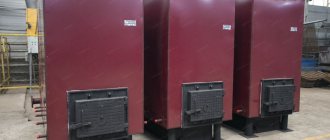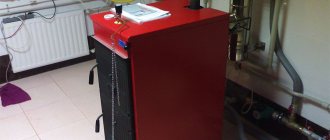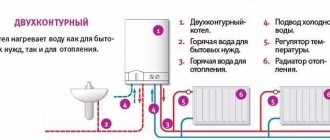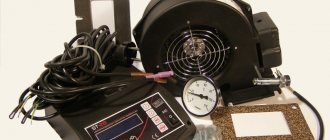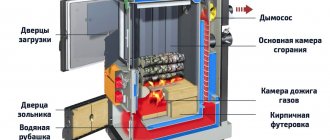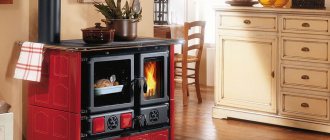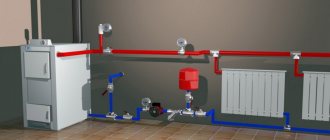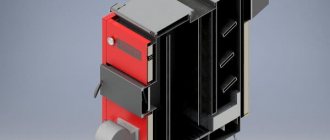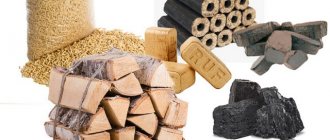Home / Solid fuel boilers
Back
Published: 05/14/2019
Reading time: 5 min
0
3992
Boiler manufacturers offer a wide range of boilers, differing in characteristics, purpose, type of fuel and quality. Industrial boilers can be gas, electric, solid fuel, gas-oil, combined, water-heating and steam.
Industrial solid fuel boilers are used by enterprises for heating and hot water supply needs. Such equipment is used in industrial, administrative, commercial, and agricultural buildings. Since such premises are usually large in area, they use powerful equipment that runs on solid fuel (pellets, briquettes, coal), with a power of 100 kW and above.
- 1 Pros and cons of industrial solid fuel boilers
- 2 Types of industrial solid fuel boilers 2.1 Steam boilers
- 2.2 Hot water
- 4.1 Requirements for TT boiler houses
Pros and cons of industrial solid fuel boilers
Industrial solid fuel water heating boilers are a good alternative to gas installations, especially when the gas main runs too far.
Most of these enterprises, having completed an economic calculation of the costs of design estimates, purchase and installation of gas equipment, confidently choose solid fuel boilers. Such thermal installations have both advantages and disadvantages.
The advantages include:
- autonomy;
- automatic control system;
- high heat output and efficiency (except for coal furnaces);
- variability in the choice of solid fuel;
- simple operation and maintenance;
- quick and easy installation of heating systems;
- combustion control system;
- availability of security systems.
However, it is worth highlighting the disadvantages:
- creating conditions for storing fuel reserves;
- more frequent equipment maintenance (cleaning of the firebox, chimney);
- regular monitoring of combustion processes and fuel supply;
- lack of a reliable temperature control system.
Materials and equipment
To properly equip steam heating, you need to prepare:
- heat exchanger;
- radiators;
- pipes (preferably galvanized steel, copper);
- pressure reducing valve;
- brackets;
- valves;
- clamps, elbows, fasteners;
- welder;
- hydraulic valve;
- reduction-cooling device;
- pump;
- container for collecting condensed steam.
Advice! To minimize the cost of organizing steam heating, expensive equipment can be rented.
Radiators for steam heating are selected in accordance with the characteristics of the material from which they are made, taking into account the operating temperature Source otoplenieblog.ru
Heat exchanger
When building a brick stove, a heat exchange device will have to be ordered or made on your own. To do this you will need a welding machine and metal pipes. The thickness of the walls of the latter should be more than 2.5 mm. By welding they must be connected in the form of a coil. In addition, it is worth taking care of the tightness of the joints. It is important to take into account that 1 m2 of the surface of a curved spiral produces about 9 kW.
After creating the structure, it is important to check for permeability: fill it with kerosene, then outline the seams with chalk. Darkening of the latter will indicate penetration of a flammable liquid into the heat exchanger. Therefore, it is unacceptable to use such a device for heating with steam.
Self-manufacturing of a heat exchanger is only possible for people who have certain skills, tools and knowledge Source heatylab.com
Installation process
Steam heating in a private house from a stove should be installed in this way:
- When building a stove, place the heat exchanger in the combustion chamber. If the stove device is planned to be used for cooking, there should be no pipes left on top.
- Install radiators and connect the pipeline to them. To ensure natural circulation in the future, it is necessary to maintain a slope (3 mm per 1 m).
- All converters must be equipped with valves designed to remove air.
- For safety reasons, install a shut-off valve in front of each battery or one for the entire system.
- At the beginning of the circuit, install a cooling device, a pressure reducing valve.
- Connect a container to collect condensate. From it, water will flow at an angle back into the heat exchanger. It is not advisable to use a membrane expander: it is not designed for temperatures exceeding 85°C.
- When using forced circulation, install a pump directly in front of the stove (in the return circuit).
Important! Heating systems with natural circulation of steam do not require the installation of a tank or pumping equipment. Therefore, their work does not depend on the presence or absence of electricity.
If heating is planned to be done with solid fuel (for example, wood), then metal pipes must be used to install the system Source 1poteply.ru
Types of industrial solid fuel boilers
Steam boilers
Boiler units producing saturated and superheated steam are necessary for heat supply, hot water supply and for the operation of steam engines.
The temperature of the saturated steam is 100ºC under a pressure of 100 kPa. The temperature of superheated steam reaches 500ºC with a pressure above 26 MPa. The purpose of these types of steam is different: saturated steam is used to supply heat to residential buildings, and superheated steam is used by industrial enterprises and in the energy complex. The operating principle of a steam boiler is to generate steam by heating water when burning fuel.
The scheme for heating water and generating steam is as follows:
- The prepared water is directed using a pump into a container in the boiler.
- Next, the water enters the collector.
- After the collector, the water rises again to the fuel combustion zone.
- Steam is generated in the pipes and rises upward.
- The steam follows further into the separator, where steam and water are separated, after which the steam passes into the steam line.
The structure of a steam boiler includes a tank where water is converted into steam, a furnace where fuel is burned, a chimney, water treatment and safety systems. Steam boilers are classified according to several characteristics.
Type of fuel:
- gas;
- coal;
- fuel oil;
- electric.
By purpose:
- household;
- industrial;
- energy;
- recycling.
By design:
- gas pipes;
- water tube
Hot water
Hot water boilers are used for heating and supplying hot water. Despite the main purpose of such boilers, recently they are increasingly used in industrial enterprises to meet technological needs, where a total heating output of more than several megawatts is not required.
The operation scheme of hot water boilers is direct-flow. It consists of sequential heat exchangers located in the combustion chamber and gas ducts. In previous decades, manufacturers produced boilers from cast iron, usually with a power of up to 1.7 MW and a coolant temperature of up to 115 ° C at a pressure of 0.4 MPa. The design of such boilers involved the assembly of cast iron sections, the number of which determined the heating capacity. Nowadays, mainly steel water-tube boilers are produced with a wide choice of power - from 30 kW to high-power boilers of 120 MW and water temperature up to 200 ° C at a pressure from 0.75 to 2.4 MPa.
What is this equipment?
The operating principle of such a steam apparatus is based on the use of heat, which is generated as a result of fuel combustion, to generate steam. Energy conversion occurs in such a boiler.
As a result of combustion, the chemical energy of the fuel is released, which then turns into thermal energy. It is transferred to water, which, when heated, evaporates and turns into water vapor.
These processes take place in the furnace of the apparatus; for their proper functioning, fuel and oxidizer are required.
For a solid fuel boiler this can be:
- Natural gas
- Fuel oil
- Coal
The role of the oxidizing agent is played by oxygen, which enters the apparatus along with atmospheric air.
Requirements for the premises for installing an industrial TT boiler
To install a solid fuel boiler, you must follow the requirements for the room where it is installed:
- Height. The room for a solid fuel boiler must have a ceiling height of 2.5 meters.
- The distance from the top of the boiler to the ceiling must be maintained at least 70 cm.
- For ease of loading fuel, it is necessary to maintain a distance from the front of the boiler to the opposite wall of no less than 2 meters.
- There must be a distance of at least 1 meter between the boiler and the side wall or adjacent boilers.
- The walls of the room must comply with fire resistance class EI45 (45 minutes) to avoid fire in other rooms if the boiler catches fire. The wall material is brick covered with plaster.
- Boiler room doors should preferably face the street; if this condition is not possible, then fire doors with fire resistance class EI30 (30 minutes) must be installed. Doors and windows must be sealed to prevent the spread of gases and smoke. The width of the doorway must be at least 800 mm - this is a condition for normal evacuation of people in the event of an accident and a necessity when moving equipment and fuel.
Fuel: firewood, pellets, coal
Previously, boilers were designed exclusively to use solid fuels such as coal. Their design was such that the energy carrier thrown into the firebox burned out too quickly. This led to a large consumption of both material and money spent on it over the entire heating season. But today technologies provide different types of fuel with a solid component , which are organically integrated into the system, burn longer, and give off more heat. Modern boilers can now operate on:
- brown or black coal;
- coking substances;
- wood logs;
- remnants of furniture production;
- pellets – peat briquettes;
- pressed shavings, sawdust;
- combined versions.
In terms of benefits, the least expensive materials for starting a technical boiler are firewood and industrial waste, shavings , if it is possible for the boiler room to receive them. In some cases, enterprises have the opportunity to receive industrial waste as combustible material free of charge. The next most expensive item is coal. And the most expensive heating materials are pellets. In addition, it should be mentioned that these briquettes are not so available on the market; not every store has them in stock.
For solid energy, you always need a separate warehouse , because you need to store coal or firewood somewhere throughout the winter. In this regard, even greater savings occur when the building for storage belongs to the company whose buildings are heated. But if you have to rent space for storing flammable materials, then this in itself is an additional expense.
Block boiler houses using solid fuel
A block boiler room is a small-sized modular room in which the process of burning fuel and heating water in heat exchangers takes place to meet the needs of heating and hot water. Sometimes for the construction of a boiler house it is necessary to use several such blocks, each of which performs the functions provided for by the project. Each object requires an individual calculation of a block-modular boiler room.
The scope of application of such solid fuel boiler houses is very wide. They are used for heating industrial, administrative, commercial, and agricultural facilities with an area of up to 10 thousand sq.m.
The advantage of using a block-modular boiler house is high autonomy, efficiency, high efficiency, unpretentiousness in operation, low installation costs, and the ability to transport the boiler house to another facility.
BMK are quite easy to operate and do not require constant monitoring by maintenance personnel. Fuel supply is carried out automatically. The design provides for the installation of fire protection equipment and sensors that ensure high reliability.
Requirements for TT boiler houses
The dimensions of the boiler room must satisfy the condition of free access to all parts of the equipment, since the operation of boiler equipment requires regular inspections and inspections.
Based on this, the minimum area of the boiler room is calculated:
- for equipment with a total power of up to 30 kW - at least 3 sq.m.;
- for equipment with a total power from 30 kW to 60 kW - at least 5.5 sq.m.;
- for equipment with a total power of 60 kW - at least 6 sq.m.;
- The height of the boiler room from floor to ceiling must be at least 2.5 m.
The design of the boiler room and the materials of walls, windows and doors must ensure tightness and fire resistance for at least 45 minutes. To fulfill this requirement, the walls of the boiler room are covered with fire-resistant plaster with a layer of at least 3 mm. A steel sheet with a thickness of 0.8 mm or more is laid under the boilers. These requirements are the same for any equipment of any brand. And even with the best solid fuel boilers with reliable protection and high-quality manufacturing, compliance with the equipment conditions of the boiler room is mandatory.
Comparison of products of foreign and local companies
When choosing a boiler to heat your home, you want it to be reliable and economical. Therefore, you should study the entire market of the products offered in advance, which will help you find the best option. Steam equipment is represented on the market by products from various manufacturers.
It differs in quality and price, which means you always have the opportunity to buy a device that meets your requirements. Among all the variety, the models that have the ideal combination of price and quality are in greatest demand. It is precisely such a wood-burning steam boiler that will be discussed below.
Let's start our acquaintance with steam boilers with products from a Turkish manufacturer - these are devices from the Akkaya HYB series. They are capable of producing up to 12,000 kg of steam per hour. Moreover, this equipment can operate on any fuel. The design of such a unit has two sections: a three-chord fire tube and a pre-furnace in which fuel is burned.
The standard equipment of the boilers includes components and parts from well-known European manufacturers, which guarantees their reliability and high quality.
The domestic manufacturer represents a steam boiler operating on solid fuel, models KSP-500. They are used to generate steam, supply heat and prepare hot water using water heaters. They can produce steam with a maximum temperature of up to 175 ° C and a pressure of 0.9 MPa.
The main advantage of such devices is the ability to work in remote regions where gas or electricity is not available to the consumer.
The following can serve as fuel for it:
- Firewood
- Coal
- Briquettes
Having a decent level of efficiency and a convenient design, such boilers are widely used by consumers. Their only drawback is their large dimensions, which means you have to think about boiler room equipment in advance.
Another representative of local manufacturers is the device model E 1/9. It has high economic performance and low heat loss. But these boilers are industrial models and are widely used in industry.
Wood-fired steam boilers of this series have high efficiency, which was achieved through the use of screening systems. The main type of fuel for them is coal. The device is a single unit, which allows it to be transported and installed in the shortest possible time.
The drums of a solid fuel boiler are located in a vertical plane and are united into one unit by tubes. The combustion chamber is made of side screens that unite the collectors of the apparatus from below. The back and front walls are made of brick, which ensures long-term operation of this equipment.
Another prominent representative of this class of equipment is the Ferroli company. Its product line includes three-chord steam boilers that operate at pressures up to 25 bar.
Their package includes all the auxiliary equipment necessary for normal functioning:
- Feed pump
- Steam valve
- Safety valves
- Electrical relays and sensors
They help make the boiler operate more efficiently and reliably. The advantages of these devices include their wide range, high efficiency, ease of operation and a developed service network.
Coolant: water, antifreeze, propylene glycol
The equipment may also differ in the method of loading the energy carrier - manually, or mechanically from a special bunker. Some models may have movable grates, while others may have stationary ones. Others are equipped with pre-furnace chambers. What kind of coolant will be chosen for such a boiler room does not make much difference. The boiler can heat:
- water;
- antifreeze;
- propylene glycol.
Of all the options, water is the cheapest. But it must be drained from the system if it is not used in winter, and it also creates a deposit of scale that can clog pipes and radiators. Antifreeze and propylene glycol do not freeze during winter downtime and do not clog pipes with scale.
Areas of application of industrial steam boilers "Ural-Power".
- Steam boilers for the food industry: dairy plants and dairies, breweries and breweries, cheese factories, creameries (fat production), meat processing plants, fish processing plants and fish factories, canneries.
- Steam boilers for agriculture: agricultural holdings, mushroom factories.
- Steam boilers for the production of building materials: reinforced concrete plants and concrete plants, bitumen plants, asphalt plants.
- Steam boilers for the wood processing and pulp and paper industries: wood processing, cardboard production and cardboard factories, pulp and paper mills, corrugated cardboard production, plywood production and plywood factories.
- Steam boilers for the oil and gas industry: tank washing, well washing , equipment washing .
- Steam boilers for light industry: clothing factories and sewing workshops, textile factories and textile plants, leather factories .
The most common for the listed areas is an industrial gas steam boiler and an industrial diesel steam boiler .
